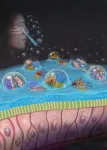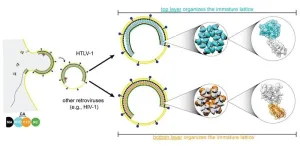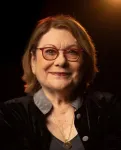(Press-News.org) When thinking of animal camouflage, we typically imagine creatures remaining still, blending seamlessly into their surroundings. But remaining motionless isn’t always practical, and many animals are highly mobile, constantly moving through their environment to graze their food.
New research suggests that high-contrast patterns on animals’ bodies may serve a dual purpose: offering camouflage when stationary, then creating a ‘motion dazzle’ effect when moving, confusing potential predators into misjudging their location – and helping them avoid being eaten.
The study, by Dr Louise Tosetto, Professor Nathan Hart and Dr Laura Ryan from Macquarie University’s School of Natural Sciences and published in PeerJ on 26 September, is the first to show that humbug damselfish – known for their striking black and white stripes – use motion dazzle as a defence strategy.
“Our findings also show that humbug damselfish adapt their behaviour based on their environment,” says Dr Tosetto.
“In their natural habitat, when they encounter backgrounds resembling their own striped patterns, like branching corals, they tend to move closer and reduce their movement. This likely helps them blend in and stay hidden from predators.
“However, when feeding outside the coral colony, where camouflage is less effective, they increase their movement and rely more on the confusing effects of their stripes, known as motion dazzle.”
Methodical study
Humbug damselfish are small, striped coral reef fish that often live in social groups protected by branching corals. While their stripes help camouflage them when still, these fish frequently move to feed, risking predator attacks.
The research team studied how different backgrounds might affect the fish’s ability to confuse predators using motion dazzle, by filming humbugs swimming in tanks against various striped backgrounds, then using computer models to simulate how predators like coral trout would see this movement.
They also used anatomical data from the retinas of humbug damselfish to help understand how clearly the fish might see different striped patterns in their environment.
The team found that when they were against backgrounds where predators would find it hard to see them clearly, humbugs tended to move closer to the background and increase their overall movement, so their own stripes would create confusing motion cues – anti-predator behaviour.
But when the background had clear, wider stripes that predators could easily see, the fish gained two advantages. First, the edges of their bodies became less distinct, making them harder to spot. Second, the combination of their own stripes and the background stripes created confusing motion signals (motion dazzling), so predators couldn’t accurately judge the speed or direction of the humbug fish.
“This suggests that humbugs can see different backgrounds and might then change their behaviour to improve their protection from predators,” Dr Tosetto says.
Senior author Dr Ryan says the findings show that these fish have complex anti-predator strategies.
“This is an essential baseline study that provides new insights into the motion dazzle phenomenon,” says Dr Ryan.
“Future research should investigate how factors like the water’s light-filtering properties and interactions with other damselfish might affect motion dazzle. The humbug damselfish offers a perfect model to explore these important questions.”
Louise Tosetto, Nathan S. Hart and Laura A. Ryan (2024) Dazzling damselfish: investigating motion dazzle as a defence strategy in humbug damselfish (Dascyllus aruanus). Peer J, 25 Sep 2024 DOI 10.7717/peerj.18152
END
Humbug damselfish use 'motion dazzle' to evade predators
2024-09-25
ELSE PRESS RELEASES FROM THIS DATE:
Can a drug-free nasal spray protect against deadly respiratory infections?
2024-09-25
New research published in Advanced Materials reports a novel nasal spray for preventing respiratory infections. The spray works by forming a protective coating on the nasal cavity, which captures airborne respiratory droplets and acts as a physical barrier against viruses and bacteria, while effectively neutralizing them.
In studies conducted on mice, the Pathogen Capture and Neutralizing Spray (PCANS) demonstrated up to 8 hours of nasal retention. In a severe Influenza A model, a single pre-exposure dose of PCANS resulted in a greater than 99.99% reduction ...
Do natural disasters jeopardize women’s reproductive health?
2024-09-25
In research published in Brain and Behavior, investigators found increased rates of menstrual irregularities in women living in areas affected by the 2023 earthquake in Turkey.
In the study, 309 women of reproductive age living in regions declared as disaster areas completed online forms 9 months after the earthquake. Responses revealed an increase of menstrual irregularities from 14.3% before the earthquake to 44.8% after the earthquake. Risk factors for menstrual irregularities included post-traumatic stress symptoms, chronic diseases, and smoking.
The findings reveal that reproductive health ...
Can cosmic radiation in outer space affect astronauts’ long-term cognition?
2024-09-25
During missions into outer space, galactic cosmic radiation (GCR) will penetrate current spacecraft shielding and thus pose a significant risk to human health. Previous studies have shown that GCR can cause short-term cognitive deficits in male rodents. Now a study published in the Journal of Neurochemistry reveals that GCR exposure can also cause long-lasting learning deficits in female rodents.
The impact of GCR on cognition was lessened when mice were fed an antioxidant and anti-inflammatory compound called CDDO-EA.
Beyond ...
Do preventive health technologies promote or harm consumers’ wellbeing?
2024-09-25
Preventive health technologies—such as wrist-worn activity trackers or health and fitness apps—are popular tools for promoting wellbeing, but new research published in the Journal of Consumer Affairs reveals that consumer engagement with these technologies can be considered a double-edged sword.
The study, which involved 30 in-depth interviews with users, found that consumers engage with preventive health technologies based on a variety of health goals—for example, to lose weight, improve performance, monitor data of an enjoyable activity, or acquire a healthy routine.
These diverse goals led users ...
Preclinical studies suggest a drug-free nasal spray could ward off respiratory infections
2024-09-25
Researchers from the Brigham detail how the spray they created may offer broad-spectrum protection from respiratory infections by COVID-19, influenza, everyday cold viruses, and pneumonia-causing bacteria
A new study details how a nasal spray formulated by investigators from Brigham and Women’s Hospital, a founding member of the Mass General Brigham healthcare system, may work to protect against viral and bacterial respiratory infections. Based on their preclinical studies, the researchers say the broad-spectrum nasal spray is long-lasting, safe, and, if validated in humans, could play a key role in reducing respiratory diseases ...
Campylobacter jejuni-specific antibody gives hope to vaccine development
2024-09-25
Bacterial infections resulting in enteritis, sometimes extra-intestinal infections such as sepsis, continue to be a global health concern. A leading cause of diarrheal and extra-intestinal infectious mortality among children under 5 and elderly persons is infection with Campylobacter bacteria, against which there is no effective vaccine or medication. An Osaka Metropolitan University-led team has recently uncovered what could be an important step toward preventing, diagnosing, and treating a species of Campylobacter bacteria.
Researchers including Professor Shinji Yamasaki and Associate Professor Noritoshi Hatanaka of the Graduate School ...
A viral close-up of HTLV-1
2024-09-25
Martin Obr is on edge, anxiously waiting for his train to the airport. A storm called “Sabine” is brewing, shutting down all public transport. He catches his flight from Frankfurt to Vienna just in time.
Obr spent the last days in Germany meticulously analyzing what he calls the “perfect sample”. This sample helped him and Florian Schur from the Institute of Science and Technology Austria (ISTA) decode the structure of a virus called HTLV-1 (Human T-cell Leukemia Virus Type 1).
In collaboration with the University of Minnesota and Cornell University, ...
Virtual reality can help pedestrians and cyclists swerve harmful pollutants – study
2024-09-25
Physics-informed virtual reality could be key to reducing the exposure of pedestrians and cyclists to harmful, non-exhaust vehicle emissions, according to a study published today (25 Sep) in the Royal Society Open Science journal.
The research lead by the University of Birmingham (supported by Rosetrees Trust and Research England QR Funding), targets the issue of major health risks and chronic diseases caused by exposure to unregulated particle pollutants from road, tyre and brake sources by providing easy, accessible guidance to the public, policy makers, and city planners, through immersive VR experiences.
Detailed ...
Neuroscience luminary Hermona Soreq sheds light on the roles of RNA regulators in neurodegenerative diseases
2024-09-25
In a compelling Genomic Press Interview published in Brain Medicine on September 25, 2024, Professor Hermona Soreq of the Hebrew University of Jerusalem in Israel unveils the profound implications of her groundbreaking research on the cholinergic system and small RNA regulators in brain-body communication.
Prof. Soreq, holder of the Endowed Slesinger Professorship of Molecular Neuroscience, has dedicated her career to unraveling the complexities of the parasympathetic nervous system, with a particular focus on acetylcholine's role in stress responses and neurodegenerative diseases. Her work has revolutionized our understanding of how the brain ...
Ancient reef-builders dodged extinction — at least temporarily
2024-09-25
Will modern coral reefs go extinct? The answer is uncertain, but some of their ancient counterparts managed to dodge a bullet — for a while, at least.
Scientists from Osaka Metropolitan University have discovered that ancient reef-building organisms called stromatoporoids survived the Late Devonian mass extinction event and continued to thrive as major reef-builders long after their presumed extinction. These findings shed light on how life on Earth has responded to past environmental changes, offering ...




